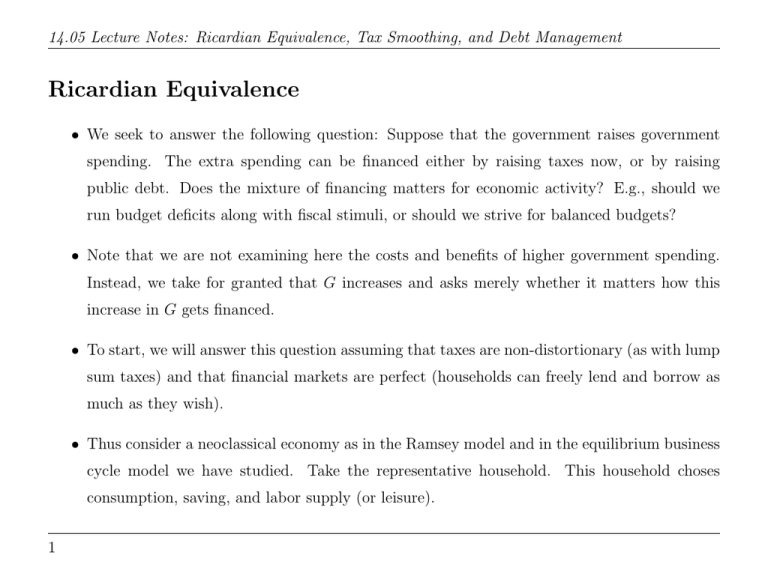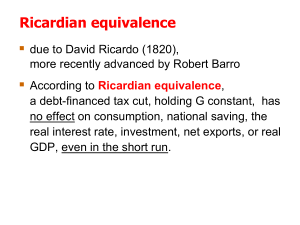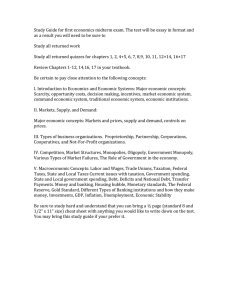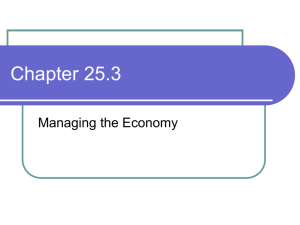Ricardian Equivalence
advertisement

14.05 Lecture Notes: Ricardian Equivalence, Tax Smoothing, and Debt Management
Ricardian Equivalence
• We seek to answer the following question: Suppose that the government raises government
spending. The extra spending can be financed either by raising taxes now, or by raising
public debt. Does the mixture of financing matters for economic activity? E.g., should we
run budget deficits along with fiscal stimuli, or should we strive for balanced budgets?
• Note that we are not examining here the costs and benefits of higher government spending.
Instead, we take for granted that G increases and asks merely whether it matters how this
increase in G gets financed.
• To start, we will answer this question assuming that taxes are non-distortionary (as with lump
sum taxes) and that financial markets are perfect (households can freely lend and borrow as
much as they wish).
• Thus consider a neoclassical economy as in the Ramsey model and in the equilibrium business
cycle model we have studied. Take the representative household. This household choses
consumption, saving, and labor supply (or leisure).
1
George-Marios Angeletos
• The household’s preferences are given by
max
τ
X
β t U (ct , lt )
t=0
were ct is consumption, lt is labor supply, β is the discount factor, and U is a utility function.
The latter increasing and concave in c (people like consuming) and decreasing and convex in
l (people dislike working).
• It’s per-period budget constraint is given by
j
ctj + at+1
= (1 + Rt )ajt + wt ltj − Ttj ∀t
where at are the assets of the household and Tt are the taxes its pays to the government (net
of any transfers it receives from it).
• Finally, household assets are given by
at = k t + bt
where kt is the capital stock and bt is the stock of government debt.
2
14.05 Lecture Notes: Ricardian Equivalence, Tax Smoothing, and Debt Management
• Following similar steps as when we studied optimal consumption smoothing (see my lecture
notes on consumption), we can show that the sequence of per-period budgets is equivalent to
the following intertemporal budget constraint:
τ
X
q t ct ≤ x 0
t=0
where
qt ≡
1
qt
=
.
(1 + R0 )(1 + R1 )...(1 + Rt )
1 + Rt
x0 = (1 + R0 )a0 +
τ
X
t=0
qt wt lt −
τ
X
q t Tt
t=0
and a0 = k0 + b0 .
• Recall that qt represents the price of period−t consumption relative to period−0 consumption
(I have normalized q0 = 1) and x0 represents the total present-value wealth of the household.
3
George-Marios Angeletos
• Consider now the government. It’s per-period budget is given by
Rt bt + gt = (bt+1 − bt ) + Tt
On the left-hand side, we have government spending plus the interest on outstanding debt.
On the right-hand side, we have tax revenue (net of any transfers) plus the money raised by
new debt issuances.
• Similarly to the case of the household, the sequence of the government’s per-period budgets
constraints is equivalent to the following intertemporal budget constraint:
τ
X
t=0
qt gt + (1 + R0 )b0 =
τ
X
q t Tt
t=0
That is, the present value of tax revenue (on the right hand side) must be just enough to
cover the present value of government spending plus the initial value of outstanding debt.
4
14.05 Lecture Notes: Ricardian Equivalence, Tax Smoothing, and Debt Management
• Substituting for
Pτ
t=0 qt Tt
from the government’s intertemporal budget into the household’s
intertemporal budget, we infer that the present-value wealth of the household is given by
x0 = (1 + R0 )k0 +
τ
X
t=0
qt wt lt −
τ
X
qt gt
t=0
It is then immediate that the household’s wealth is independent of either the outstanding level
of public debt or the financing of government spending: x0 is independent of {bt , Tt }τt=0 . All
that matters is the present value of government spending, not how this is financed.
• Since the representative household’s budget constraint is independent of {bt , Tt }τt=0 , its optimal
consumption, saving, and labor supply decisions are also independent of this. Furthermore,
the representative firm’s decisions are also independent. But if neither the households’ nor
the firms’ decisions are affected, then the equilibrium prices are also unaffected. We conclude:
Ricardian Equivalence. Suppose that markets are perfect and taxes are non-distortionary.
Then, equilibrium allocations and prices are independent of either the initial level of public
debt, or the mixture of deficits and taxes that the government uses to finance government
spending.
5
George-Marios Angeletos
• What’s going on. Suppose that the government decides to finance an increase in gt with a
increase in debt instead of an increase it Tt . This means that the government de-saves (i.e.,
it runs a deficit). The households do not change their consumption, but they have to pay
less taxes to the government. This means that they are saving more. In fact, private saving
increases by exactly the same amount as the reduction in government saving. A public-sector
deficit is thus perfectly offset by a private-sector surplus.
• Note however how this argument hinges on the household’s ability to save and lend freely. In
particular, suppose that households face tight borrowing constraints. These constraints may
force private consumption to be lower than the optimum. Think, e.g., of young or unemployed
households who would like to borrow against their future labor income, but can’t do so because
of borrowing constraint. Suppose then that the government runs a deficit now, which means
that it shifts taxes from today to the future. Once again, the present-value wealth of the
households still doesn’t change. Nevertheless, because the households have to pay less taxes
today, they are now able to afford higher consumption without having to borrow more. Since
before the change in government policy consumption was depressed due to the borrowing
constraint, consumption may now increase.
6
14.05 Lecture Notes: Ricardian Equivalence, Tax Smoothing, and Debt Management
• In effect, when the government runs a deficit, it relaxes the bite of the borrowing constraint
faced by the household. It follows that private consumption may now increase, and Ricardian
equivalence breaks. In this sense, tax rebates, transfers, and deficits may help stimulate
consumption and “aggregate demand”.
• Alternatively, suppose that household face tight borrowing constraints and the government
decided to run a deficit, not by reducing taxes today, but rather by increasing government
spending. Will this stimulate consumption? Or will it crowd out consumption? If it is the
later case, will the crowding out be full or partial?
• Finally, Ricardian equivalence breaks also when taxes are distortionary. In this case, when
the government runs a deficit, it effectively substitutes less distortions today against more
distortions in the future. As in the case of a consumer who seeks to smooth its consumption,
a benevolent government may then find it optimal to smooth tax distortions over time. This
is what is often called ”tax smoothing.” We will study this issue next.
• To recap, as long as financial markets are perfect (no borrowing constraints) and taxes are no
distortionary, the timing of taxes and the financing of government spending are irrelevant.
7
George-Marios Angeletos
Tax smoothing and debt management
• As anticipated, the dynamic pattern of taxes and deficits ceases to be indeterminate once
taxes are distortionary.
• To capture this idea, let’s us abstract from capital and labor supply, and let us capture
the distortionary effects of taxation by assuming that collecting taxes is a costly activity (it
wastes resources). This is meant to be a metaphor for the broader idea that higher taxes, by
distorting incentives for work and saving, end up reducing economic activity.
• We thus assume that real income is given by
yt = Y − Λ(Tt )
where Y is a constant that defines the level of income in the absence of taxation, Tt is tax
revenue, and Λ is an increasing and convex function representing the resources wasted because
of taxation (with Λ(0) = 0, Λ(.)0 > 0, Λ(.)00 > 0).
8
14.05 Lecture Notes: Ricardian Equivalence, Tax Smoothing, and Debt Management
• The government budget constraint:
Rt bt + gt = (bt+1 − bt ) + Tt
• The household budget:
ct + bt+1 = (1 + Rt )bt + yt
• Combing the two, and using the definition of yt , we reach the following representation of the
resource constraint of the economy:
ct + gt = Y − Λ(Tt )
9
George-Marios Angeletos
• Suppose now that the preferences of the household are linear in consumption:
U=
X
β t U (ct )
t
with
U (c) = c
• From the Euler condition we then immediately get that
U 0 (ct ) = β(1 + Rt+1 )U 0 (ct+1 )
1 = β(1 + Rt+1 )
and therefore
Rt+1 = R = ρ
ρ≡
1−β
β
That is, the interest rate is constant over time and equated to the household’s subjective
discount rate.
10
14.05 Lecture Notes: Ricardian Equivalence, Tax Smoothing, and Debt Management
• Now, let us take the sequence of government spending as given, and let us consider the
problem of a benevolent government that chooses the sequence of taxes and public debt so as
to maximize social welfare (the life-time utility U of the representative household).
• Using the facts that
U (ct ) = ct = yt − gt = Y − Λ(τt ) − gt
we can express welfare as
U=
X
β t [Y − Λ(τt ) − gt ]
t
• Next, using the fact that β(1 + Rt ) = 1, or equivalently
qt = β t ,
and setting b0 = 0 for simplicity, we can restate the intertemporal government budget constraint as
X
t
11
β t gt =
X
T
β t Tt
George-Marios Angeletos
• We can thus state the policy problem as
X
max U =
β t [Y − Λ(τt ) − gt ]
{Tt }
t
subject to
X
β t Tt =
X
β t gt
t
T
• Clearly, since both Y and {gt } is exogenous, the above problem is equivalent to the following:
X
min
β t [Λ(τt )]
{Tt }
t
subject to
X
ˆ
β t Tt = G
T
ˆ≡
where G
P
t
t
β gt is the present value of government spending.
• The above problem has a simple interpretation: the government must choose the sequence
of taxes (and deficits) so as to minimize the present value of the social cost of tax distortions, pretty much as a consumer chooses the sequence of consumption (and saving) so as to
maximize the present value of the utility of consumption.
12
14.05 Lecture Notes: Ricardian Equivalence, Tax Smoothing, and Debt Management
P t
• Note in particular that the present value of tax revenue,
T β Tt , is pinned down by the
P
ˆ≡
present value of of government spending, G
β t gt (which is here treated as exogenous).
t
In this regard, the “average” deficit has to be zero over time: if the government borrows at
some period, it has to pay back its debt at some other periods. However, the government
is free to choose the timing of taxes and debt: it is free to run deficits in some periods and
surpluses in other periods.
• The question of interest then is to understand what is the optimal strategy in terms of when
to run deficits and when to runs surpluses. To do this, we first ask what is the optimal path
of taxes over time. Once we figure out the optimal taxes, the optimal primary deficit/surplus
of period t is given simply by the residual between the (exogenous) spending gt of that period
and the (optimally chosen) tax revenue Tt of that period.
13
George-Marios Angeletos
• To determine the optimal taxes, take the FOC of the government’s optimization problem to
get the following:
Λ0 (Tt ) = λ ∀t
where λ is the Lagrange multiplier on the government’s intertemporal budget. And since Λ0
is strictly increasing (the distortionary costs of taxation are convex in the level of taxation),
we conclude that the optimal policy is to equalize the tax rate across periods:
Tt = T ∗ ∀t
P
ˆ ≡
• The level of T ∗ is then pinned down by the intertemporal budget: using t β t Tt = G
P t
∗
t β gt from the intertemporal budget along with Tt = T ∀t from the aforementioned optimality condition, we get
β t gt
1−β
∗
which means that T is equated to the annuity value of government spending.
∗
T =
P
t
(1)
• Clearly, this is similar to how a consumer equates his optimal level of consumption with the
annuity value of his income, when the interest rate equals the discount rate and consumption
is perfectly smoothed.
14
14.05 Lecture Notes: Ricardian Equivalence, Tax Smoothing, and Debt Management
• Now, suppose that
gt = ḡ
for all t. In this case, (1) reduces to
T ∗ = ḡ
and therefore the government runs a balanced budget in each period.
• Starting from the above situation, suppose that suddenly (and for reasons exogenous to our
analysis here) government spending increases permanently to a new higher level:
gt = ḡ + ∆,
∆ > 0. Then, (??) gives
T ∗∗ = ḡ + ∆
which means that taxes shift up permanently and by the same amount as government spending, so that the government runs a balanced budget once again.
• Permanent increases in government spending therefore lead to equal permanent increases in
taxes and no change in surpluses/deficits.
15
George-Marios Angeletos
• Now, suppose instead that there is a temporary increase in government spending. Think, e.g.,
of a temporary fiscal stimulus lasting X years:
gt = ḡ + ∆ for t = 0, ..., X − 1 but gt = ḡ ∀t > X.
In this case, (1) reduces to
T ∗∗∗ = ḡ +
1 + β + ... + β X
∆
1−β
• If the interest rate is a small number R (say, R is a couple percentage points) and the length
X is also small (say, X is a couple of years), the above gives
T ∗∗∗ = ḡ + RX · ∆
where RX << 1. For example, with R = 0.025 and X = 2, we get that, during the two
years of the fiscal stimulus, the increase in taxes should be about only RX = 5% of the
contemporaneous increase ∆ in government spending. That is, almost all the fiscal stimulus
must be financed with deficits. But after g returns to its normal level, taxes must remain
higher for ever, in order to run primary surpluses that will pay for the interest on the debt
that it got accumulate during the fiscal stimulus.
16
14.05 Lecture Notes: Ricardian Equivalence, Tax Smoothing, and Debt Management
Tt , gt
← fiscal stimulus →
deficits
Tt
surpluses
t=0
17
t=X
gt
t
MIT OpenCourseWare
http://ocw.mit.edu
14.05 Intermediate Macroeconomics
Spring 2013
For information about citing these materials or our Terms of Use, visit: http://ocw.mit.edu/terms.







